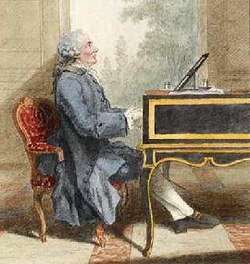L'école de la jeunesse
L'école de la jeunesse ou Le Barnevelt françois (The School of Youth or The French Barnwell) is an opéra comique (specifically a comédie mêlée d'ariettes) in three acts by the composer Egidio Duni. The libretto, by Louis Anseaume, is based on George Lillo's play The London Merchant or The History of George Barnwell (1731). The opera was first performed at the Opéra-Comique, Paris on 24 January 1765.
| Egidio Duni |
|---|
 |
|
Operas
|
Main roles
| Cast | Voice type | Premiere Cast,[1] 24 January 1765 (Conductor: -) |
|---|---|---|
| Cléon | tenor | Jean-François Lejeune |
| M. Oronte, Cléon's uncle | baritone[2] | Joseph Caillot |
| Sophie, bethrothed to Cléon | soprano | Marie-Thérèse Laruette, 'Madame Laruette' |
| Dubois, a valet of M. Oronte | tenor[3] | Jean-Baptiste Dehesse |
| Hortense, a young widow | soprano | Pétronille-Rosalie Beaupré |
| Finette, an attendant of Hortense | soprano | Eulalie Desgland(s) |
| Mondor, a friend of Hortense | haute-contre | Jean-Louis Laruette |
| Damis | tenor[3] | Robert Desbrosses |
| Javard, a creditor of Cléon | basse-taille (bass-baritone)[4] | M. Renaud |
| A Gascon knight | haute-contre | Antoine Trial |
| A baron | basse-taille (bass-baritone)[4] | not reported |
| A singer | tenor[5] | M. Lobreau |
| A milliner | spoken | Rosalie Lafond |
| A bailiff A pedlar |
spoken | Gabiel-Éléonor-Hervé Dubus Champville, 'Soli' |
| A valet | spoken | not reported |
gollark: øøøø.
gollark: I'm sure you'd like me to think that you'd like us to think so.
gollark: Also use of most of this (https://github.com/satwikkansal/wtfpython) and the mildly exotic features like decorators.
gollark: If I were to enter this I may deliberately write my programs in the most stupid and ridiculous way possible (or at least I find it favorable to claim that now maybe), such as by, for example, using preprepared pickle streams for arbitrary code execution, doing everything in one line, horrible overuse of `exec`/`eval`, using that thing where python will execute code from a ZIP concatted onto an image, downloading data from pastebin or whatever, blatantly ignoring all available Python style guides, or mucking with the AST module and importlib to transform the code into other stuff.
gollark: Iterator functions vs for loops, classes versus namedtuples and dataclasses and whatever else, APLish array programming type solutions versus... not that?
References
- Notes
- According to the original libretto.
- Caillot, the first performer, was endowed with a very wide compass which enabled him to sing as a basse taille, but also to reach up to the haute-contre tones (Jean Gourret, Histoire de l'Opéra-Comique, Paris, Les publications universitaires, 1978, p. 43). According to Rodolfo Celletti "he was a baritenor and a bass at the same time": Grétry and Monsigny used to notate his parts in the bass clef, but to set them in high-baritone tessiture (Voce di tenore, Milan, Idealibri, 1989, p. 59, ISBN 88-7082-127-7).
- Notated in the tenor clef in the original score.
- Notated in the bass clef in the original score.
- The role of 'Le chanteur' is assessed as a tenor part by Elisabeth Cook. It is notated in the tenor clef in the original score.
- Sources
- Original libretto: L'École de la jeunesse, ou Le Barnevelt français, Comédie. En trois Actes et en vers, mêlée d'ariettes, Paris. Duchesne, 1775 (accessible online as a Google ebook-gratis)
- Original score: L'École de la jeunesse, ou Le Barnevelt françois, Comédie. En trois Actes et en vers, Paris, Chez l'Auteur & Lyon, Chez Castaud, s.d. (accessible for free online at Gallica - B.N.F.
- Casaglia, Gherardo (2005)."L'école de la jeunesse, 24 January 1765". L'Almanacco di Gherardo Casaglia (in Italian).
- Cook, Elisabeth (1992), 'Ecole de la jeunesse, L in The New Grove Dictionary of Opera, ed. Stanley Sadie (London) ISBN 0-333-73432-7
This article is issued from Wikipedia. The text is licensed under Creative Commons - Attribution - Sharealike. Additional terms may apply for the media files.